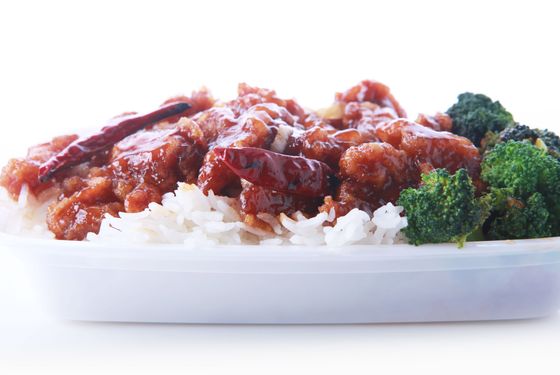
If it’s possible for a dish as iconic and ubiquitous as General Tso’s chicken to experience a renaissance, it’s happening now. Since it was announced last year and released last week, the documentary The Search for General Tso, which traces the origins of the dish, has sparked a renewed appreciation in the Chinese-American staple. It’s one of America’s great dishes, available nearly everywhere, and is almost always satisfying — but why, exactly? To help understand its appeal, Grub checked in with chefs around the city to get their thoughts on what makes General Tso’s so damn good.
Ed Schoenfeld, RedFarm
“I actually was part of the very small group of people who introduced this dish to the United States, and I’ve seen it literally from the day it arrived in the United States until now. There’s no one else like me who was in this country, and in this industry, who lived through this and who still is in business opening Chinese restaurants and selling this kind of food. Not that we sell that at RedFarm — we don’t.
In the Hunan province, the palate traditionally was to have spicy sauces that were kind of salty, spicy, and a little bit tart. Chef [T. T] Wang at Shun Lee changed it a little to please the American palate, and rather than making it vinegary and tart, he made it spicy and a little tart and sweet. In a lot of takeout places, it’s 75 percent batter and 25 percent chicken, and really, when you make it the proper way, what you’re serving are chunks of chicken that have a very thin and crispy coating on them. It’s something that I like to cook for myself.
In the early 1970s, authentic Chinese food was a very exciting, cutting-edge Asian cuisine. Things changed over the years, and it has become our main home replacement food. It’s the food that everyone calls up and takes out. There was kind of a downgrading over the years as the industry got bigger, and General Tso’s chicken was symbolic of that, or a part of that, but there’s nothing that prevents restaurants from cooking it in a really good way … I saw it go from a dish that only two restaurants in the United States were serving to a dish that has now makes literally billions of dollars in sales. It’s kind of amazing how ubiquitous it’s become.”
Jonathan Wu, Fung Tu
“I think embracing General Tso’s chicken is freeing for an American who cooks Chinese food because it is, in a way, saying, ‘I don’t give a fuck about authenticity.’ In addition, General Tso’s chicken is cheap and comforting: easy to enjoy; not cerebral or challenging. Now, chefs who have trained in ‘highbrow’ kitchens are opening places where they don’t give a fuck about authenticity and are cooking the stuff that they like to eat, often cheap and comforting food.
In a way, I think it’s the dish defines Chinese-American cooking. General Tso’s chicken is very sweet. The proportion of chicken (protein) to vegetables is high. Lots of sugar and lots of meat — that is America. Just like barbecue and lots of soul food … It has not informed my style of cooking. That said, I did reverse engineer the sauce used for the Sino-Indian fusion dish: Gobi Manchurian — the sauce is used for Fung Tu’s Sweetbreads Manchuri. It turns out that this sauce is sweet and sour — just like General Tso’s.”
Wylie Dufresne, Alder
“Cooks have historically found themselves eating this type of food late at night, at least in New York City. What’s not to like about slightly sweet, slightly spicy, deep-fried chicken? It’s delicious. It also lends itself to being copied in fun and clever ways. The Chinese figured it out centuries before the rest of us did. There are some unusual universals in the world of cooking, and that flavor profile is one of those things. I find it somewhat undeniable.
And it has an interesting story in the role it’s played in the history and evolution of Chinese food in America. It’s a symbol, at the very least, of that integration. Traditional Chinese food is great. Good Chinese-American food is great, even if it suffers from an excessive kitsch. Things like a Pu-Pu Platter sound silly, but are delicious! General Tso’s chicken might seem like cartoon Chinese food. But the Chinese are one of the greats at taking a ton of ingredients and making something delicious and well-balanced. That’s a lot of the art in great Chinese food — how many ingredients can come together in a balanced way. “
David Waltuck, élan
“It has spice, sweetness, and it is essentially a form of comfort food in that it is so ubiquitous. I think it represents a second or third generation of Chinese-American cooking — the first being foods like chow mein and chop suey, General Tso’s is kind of dumbing down of the Hunan and Szechuan cooking that was introduced in the ‘70s. It’s only a problem if people mistake it for real Chinese food, which I think lots of people do. But it’s mildly exotic without being in any way off-putting. It is something one can find almost anywhere in the U.S., so it is something people feel is “safe” and familiar.
I do like playing with both real Chinese food and bogus Chinese food, as in takeout cuisine. At élan, I serve a dish which I call “General Tso’s” Sweetbreads, which is sort of a mash-up of General Tso’s and Orange Chicken. It is based on something I made at Chanterelle, which was sweetbreads with caramelized leeks and orange, and which the cooks sometimes referred to as General Tso’s Sweetbreads as a joke. I decided to go all the way with it at élan in terms of its General Tso-ness.”

Anita Lo, Annisa
“It’s one of those iconic Chinese-American dishes. As far as I understand, it’s unclear where it came from. Most people in China have never heard of it. Americans love it because it’s a little sweet, deep-fried, and slightly salty. Chinese cooks came to this country, trying to cook with what they had, for a certain audience. In the right hands, it can be a fantastic dish.
I grew up in the Midwest, and it was difficult finding, for lack of a better word, more authentic Chinese cooking. General Tso’s wasn’t something that we ordered as a family. But I do like that style of deep-frying food, and having it still be crispy while covered in a sauce. I’ve cooked something like that for Chinese New Year. In the American conscience, General Tso’s is an icon.”
Doron Wong, Yunnan Kitchen
“It’s one of the dishes that American-Chinese food was built upon: There’s always a sweet-and-sour chicken or pork in Cantonese cuisine. Sweet, sour, and spicy, with a little bit of umami — those flavors are crave-worthy. About seven years ago, I did a braised pork belly. When I worked at Clio, we did General Tso’s frog’s legs. Now it’s singled out as American-Chinese food, and it’s one of the first things people think about — as well as crab ragoon and sweet-and-sour pork. Isn’t General Tso’s chicken in a shape of a meatball in some places? It’s just, like, a bunch of parts put together. That’s funny.”
Jason Marcus, Traif
“I’m Jewish. I grew up in northern New Jersey. We ate Chinese food at least once a week — or the typical Chinese-American food. With that dish in particular, the sweet and the sour aspects is what Eastern-European Jewish food is, essential. If I think of my grandma, I think of sweet-and-sour meatballs. It’s a typical flavor profile in a lot of cuisines, but it’s comforting to me and my Jewish relatives. There’s a natural appeal, and it transcends generations.
It’s also been branded correctly. It’s not ‘fried chicken with sweet-and-sour glaze-y sauce.’ It’s General Tso’s chicken. It has a name. It’s on every menu, but I don’t know if it’s necessarily better than orange or sesame chicken. But it’s the one. People like nostalgia, and it’s probably the first thing that mom and dad ordered. It’s very easy to eat, as far as being introduced to food. You’re built to like sweet-and-sour sauce.
We make General Tso’s sweetbreads at Traif during Christmas week. It’s a very heavy, gloppy kind of a dish, traditionally, and sweetbreads are nice because they’re light and delicate. The sauce is thinner and reduced down — no cornstarch. But again, it’s got the name recognition.”




